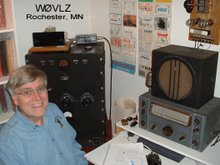My 2017 "BK" station is built around a TNT transmitter using 210s in push-pull. With it I'll use a two tube regen and/or Elecraft KX3 depending on band conditions.
 In the front left of my BK operating position is a small table-top rack holding the two receivers plus an audio output transformer connected to a battery powered amplified speaker. Like many early receiver designs my regen has B+ flowing through the headphones. The external output audio transformer makes it safe to use and allows connecting to my amplified speaker. The regen B+ supply is off to the left. I use a power supply built from an Antique Electronics Supply kit. Sitting on the ledge behind the receivers is a regulated high voltage supply. This provides B+ for my transmitter. The TNT transmitter is sensitive to B+ voltage swings. This regulated supply helps control the "whoop". Next to the power supply is a Simpson Wavemeter. This allows me to easily get my transmitter in the band. Exact frequency setting of both the transmitter (and the regen) is done using my KX3 as a frequency monitor. Next is my TNT transmitter. This one is fairly stable and produces a nice note on 40 and 80. I can see why QST featured it in 1930. To the right of the transmitter is a plate current meter. This year BK is limiting input power to 25 watts and power is part of the QSO exchange. This meter is needed for accurate reporting. The wooden box on the far right is my filament supply. It provides both 7.5 volts to the transmitter and 2.5 volts to the regen receiver. On top of the filament supply is a QRP watt meter. This is handy for setting up the transmitter for maximum output. The switch on the table switches the antenna between transmitter and receiver. The key is a Kent Straight Key used for several years by my mentor/step-father K5CF (SK). Optional equipment
includes a good cup of coffee, useful while trying to make those late
night contacts with the east and west coasts.
In the front left of my BK operating position is a small table-top rack holding the two receivers plus an audio output transformer connected to a battery powered amplified speaker. Like many early receiver designs my regen has B+ flowing through the headphones. The external output audio transformer makes it safe to use and allows connecting to my amplified speaker. The regen B+ supply is off to the left. I use a power supply built from an Antique Electronics Supply kit. Sitting on the ledge behind the receivers is a regulated high voltage supply. This provides B+ for my transmitter. The TNT transmitter is sensitive to B+ voltage swings. This regulated supply helps control the "whoop". Next to the power supply is a Simpson Wavemeter. This allows me to easily get my transmitter in the band. Exact frequency setting of both the transmitter (and the regen) is done using my KX3 as a frequency monitor. Next is my TNT transmitter. This one is fairly stable and produces a nice note on 40 and 80. I can see why QST featured it in 1930. To the right of the transmitter is a plate current meter. This year BK is limiting input power to 25 watts and power is part of the QSO exchange. This meter is needed for accurate reporting. The wooden box on the far right is my filament supply. It provides both 7.5 volts to the transmitter and 2.5 volts to the regen receiver. On top of the filament supply is a QRP watt meter. This is handy for setting up the transmitter for maximum output. The switch on the table switches the antenna between transmitter and receiver. The key is a Kent Straight Key used for several years by my mentor/step-father K5CF (SK). Optional equipment
includes a good cup of coffee, useful while trying to make those late
night contacts with the east and west coasts.In the backyard are my winter 80/40 mtr vertical and 95' inverted L antennas.








